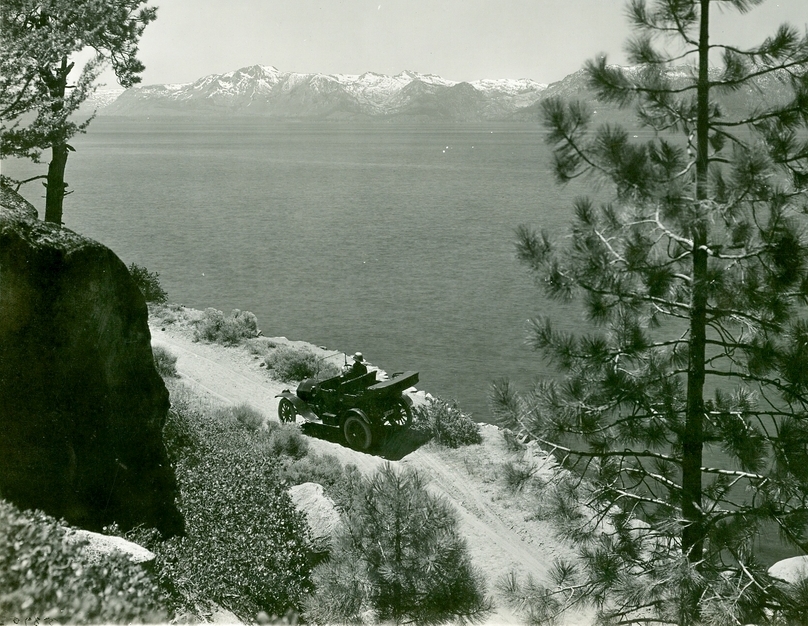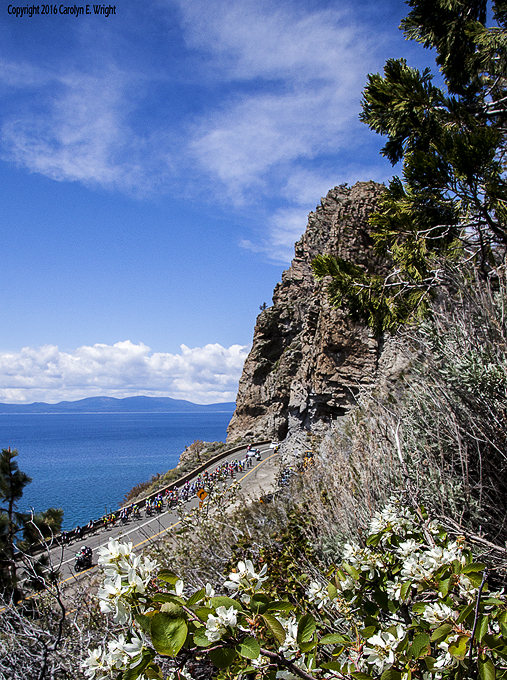Cave Rock project to tie up traffic all summer

This is a rendering of what Cave Rock will look like when the work is completed. Photo/NDOT
By Kathryn Reed
Highway 50 near Cave Rock will be reduced to one lane in each direction six days a week, including holidays, and around the clock beginning as soon as possible and lasting until the work is done in the fall.
It’s mostly about safety and a little about lake clarity.
“We are calling it a tunnel extension for simplicity. It’s almost like a bridge we are building,” Devin Cartwright, Nevada Department of Transportation engineer, told Lake Tahoe News.
He is in charge of the $5 million project that is designed to keep rocks from falling from Cave Rock onto the highway, as well as the water quality improvements taking place east of the tunnel.
Most likely the work will begin in May per Tahoe Regional Planning Agency rules, though if April is projected to be dry, exemptions could be made.
This isn’t any ordinary rock formation. For the Washoe people it is one of their most sacred places.
“NDOT invited the tribe to come up to meet with the project construction crew when they come up with a date for the start time so the tribe can talk to them to explain how it is a sacred site and not just another job,” Darrel Cruz with the tribe told Lake Tahoe News.
Cave Rock has been used by medicine men and there are other stories associated with it, Cruz said. For some people, they won’t go near the rock because of the power it holds.
The Washoe and NDOT have been meeting regularly. And while the Washoe would prefer no one touches the site, they are resigned to the fact that safety issues are a necessary reality.

People used to drive around Cave Rock. Photo/Lake Tahoe Historical Society
Sizable rocks have fallen the past couple winters that have damaged vehicles and the roadway. This project is designed to keep those rocks from reaching the road.
Temporary steel netting has been erected until the more robust solution is in place. The added benefit is that the net will act as a safety measure for workers this summer.
Cartwright said the inconsistent moisture levels because of the drought have caused more rocks to become loose and fall.
“Rapid expansion of soil causes new cracks or old ones to get bigger and things to fall,” he explained.
NDOT is also working with the state Historic Preservation Office to ensure the work is done with care.
“The exterior will be such that it blends into Cave Rock. You will see something that looks like granite or Cave Rock to the best of its ability, but it will still be square,” Cartwright said. “It will have a false surface on it made of concrete and steel so it will a have depth and texture to it like the surrounding rock.”
The tunnel will receive a face-lift of sorts. The exterior color will be closer to the natural rock. The white that has covered up graffiti will be eliminated. The goal is to make all the improvements appear as close to being original as possible, including color, patterns and texture.
The inside will be like a box. On top of it will be concrete and steel girders.
“If you imagine a set of ribs, they will run transverse to the road,” Cartwright explained. “One will be spaced about every 10 feet longitudinally. On top of there, 1 foot of concrete reinforced deck, on top of that 3 feet of pea gravel, so when rocks fall on the pea it stays loose.”
The technology comes from Japan, which has a ton of rock fall issues because of seismic activity. NDOT looked at various methods to contain the rocks, with this design seeming to be the most effective for the site and coming with the ability to be completed in one season.
The existing tunnel is 165-feet long. Sixty-two feet will be added to it.
It was in 1931 that crews first blasted through the granite monolith. It used to be one lane. Eastbound traffic went through the tunnel, while those headed west went on the outside of the tunnel by the lake. That route was eliminated after the second bore was completed in 1957.

Cyclists in the Tour of California will again ride through Cave Rock in May. Photo Copyright 2015 Carolyn E. Wright
With the tunnel being 23-feet at the narrowest, there is no room to add a bike lane. However, part of the project includes improvements for cyclists.
There is a button cyclists can hit to initiate a warning to drivers. But cyclists seldom take the time to use them. The buttons will remain as a back up, but radar will be installed so the message board is automatically triggered. NDOT will be putting in changing message signs that are similar to the ones near Lakeside Inn and Kingsbury Grade.
The existing signs for cyclists and the ones warning about ice will be removed.
“When there are no bikes or ice, it will be a black sign. It won’t add clutter. When a bike rides by it, it will light up,” Cartwright said.
Temperature sensors will be installed inside the pavement on each side of the tunnel so when it gets close to freezing it will say there is ice in the tunnel. This change will mean the warning would be legitimate instead of ongoing when the threat isn’t valid.
NDOT is adding a white surface to the ground as drivers approach the tunnel and silhouettes of bikes will be stenciled in as a warning.
The tunnel will be lighted. The roadway inside the tunnel will be repaved, as will the westbound lanes of Highway 50 and the roadway median between Cave Rock and the Cave Rock State Park boat launch entrance.
During construction the work zone speed limit will be 25 mph. This will start about one-half mile before the project area. Nevada Highway Patrol will be on site to enforce people comply. People traveling east will be in a construction zone for longer because of the water quality project.
Roadside drainage inlets and sediment filtration systems will be installed along the highway for approximately one mile that starts four miles east of Cave Rock.
Noise constraints are part of the contract. If the contractor violates them, the project could be shut down.
While the work will be ongoing all except Sundays, the contractor has the authorization to work seven days. NDOT is aware there will be nine significant events such as annual cycling and running races that will be impacted. Cartwright said the size of the event would dictate whether special traffic controls would be implemented to accommodate participants.
—–
Notes:
- NDOT is having an informational meeting about the project on April 14 from 4-7pm at Zephyr Cove Elementary School’s multipurpose room, 226 Warrior Way, Zephyr Cove. There will be a formal presentation at 5:30pm, followed by a short question and answer session. This will be an open house format meeting.